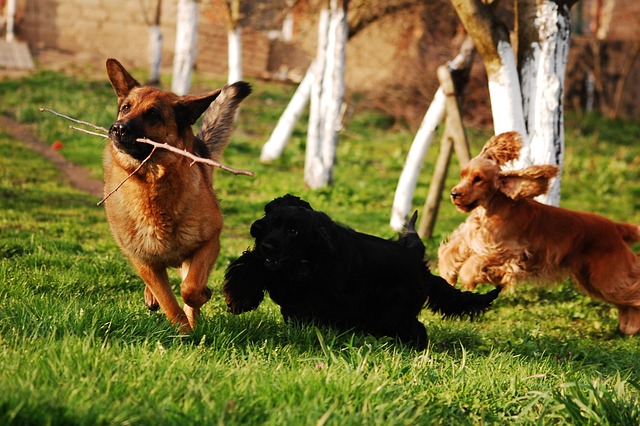Introduction: Understanding the Concept of Dog Herding
Dog herding is a fascinating practice rooted in ancient traditions. It involves guiding and controlling a group of animals, typically sheep, using specially trained dogs. This artful and purposeful act requires skill, precision, and an incredible bond between the handler and the herding dog. In this article, we delve into the world of herding, exploring its history, the breeds involved, training techniques, benefits, challenges, and its future.
The History and Origins of Dog Herding
The practice of herding can be traced back thousands of years, with its origins in the agricultural pursuits of humans. Ancient civilizations recognized the invaluable role dogs played in assisting with livestock management. Over time, selective breeding produced dog breeds with natural herding instincts, such as the Border Collie, Australian Shepherd, and German Shepherd. These breeds exhibited remarkable intelligence, agility, and a strong desire to work alongside humans.

Popular Dog Breeds for Herding
Various dog breeds have become synonymous with herding due to their innate abilities and characteristics. The Border Collie, known for its exceptional intelligence and herding prowess, is widely regarded as one of the best herding breeds. Other popular breeds include the Australian Shepherd, Australian Cattle Dog, Shetland Sheepdog, and the Pembroke Welsh Corgi. Each breed brings its unique strengths and traits to the world of herding.
The Training Process for Herding Dogs
Training a herding dog is a gradual process that involves building a strong foundation of obedience and instilling the necessary herding skills. Starting with basic commands like “sit,” “stay,” and “come,” the training progresses to teaching the dog specific herding commands such as “walk-up,” “lie down,” and “get back.”
How to Motivate The Dogs For Herding
Positive reinforcement techniques, using treats and praise, are commonly employed to motivate the dogs and reinforce desired behaviors. The training process also includes introducing the dogs to livestock and gradually exposing them to different herding scenarios.

The Skills Required for Effective Herding
Effective dog herding requires a combination of skills from both the dog and the handler. Dogs must possess natural herding instincts, intelligence, agility, and the ability to respond to commands promptly. Handlers, on the other hand, need to have a deep understanding of their dogs’ behavior, strong communication skills, and the ability to read and anticipate the movements of livestock. The partnership between the dog and the handler is crucial in achieving successful herding outcomes.
The Benefits of Herding for Dogs and Owners
Engaging in herding offers numerous benefits for both dogs and their owners. For dogs, herding provides mental stimulation, physical exercise, and an outlet for their natural instincts. It allows them to engage in purposeful work, which can enhance their overall well-being and prevent behavioral issues caused by boredom. For owners, dog herding strengthens the bond with their canine companions, promotes active lifestyles, and fosters a sense of accomplishment and pride in their dogs’ abilities.
Challenges and Considerations in Dog Herding
While dog herding can be immensely rewarding, it also comes with its own set of challenges and considerations. It requires time, dedication, and patience to train a herding dog effectively. Herding dogs often have high energy levels and a strong drive to work, necessitating regular exercise and mental stimulation. Additionally, herding should be approached with caution to ensure the safety and well-being of both the animals being herded and the dogs themselves.

Safety Measures and Equipment for Herding
To ensure the safety of all involved, certain safety measures and equipment are essential in herding. Fencing off the herding area helps prevent the escape of livestock and provides a controlled environment. Collars, harnesses, and leashes should be used appropriately to maintain control over the dogs during training and herding sessions. Additionally, proper veterinary care, including vaccinations and regular check-ups, is crucial to keep the dogs healthy and protected.
Dog Herding Competitions and Events
Dog herding competitions and events offer opportunities for herding enthusiasts to showcase their skills and witness impressive displays of canine agility. These events often include trials that simulate real-life herding situations, evaluating the dog’s ability to maneuver and control livestock effectively. Competitions foster a sense of camaraderie among handlers and provide a platform for exchanging knowledge and techniques.

The Future of Herding
As society continues to evolve, herding maintains its significance in certain communities and as a recreational activity. However, with changing lifestyles and urbanization, the practice faces challenges in terms of accessibility to suitable training areas and availability of livestock. Nevertheless, dedicated individuals and organizations continue to preserve and promote the art of dog herding, ensuring its survival for generations to come.
Conclusion
Dog herding represents a captivating blend of tradition, skill, and the unique bond between humans and their canine companions. Through centuries of selective breeding and training, herding dogs have become invaluable assets in managing livestock and showcasing their exceptional abilities. Engaging in herding offers a fulfilling experience for both dogs and their owners, fostering mental stimulation, physical exercise, and a deep sense of partnership. As we navigate the future, let us cherish and preserve this timeless practice that celebrates the remarkable agility and intelligence of our four-legged friends.

FAQs (Frequently Asked Questions)
1. Can any dog be trained for herding? Yes, many dog breeds can be trained for herding, but certain breeds have a natural predisposition for it due to their instincts and characteristics.
2. Is dog herding suitable for all owners? Herding requires commitment, time, and dedication. It is more suitable for individuals who have a genuine interest in working closely with their dogs.
3. Are there age restrictions for herding dogs? Herding dogs can begin their training as early as 6-8 weeks old. However, the intensity and complexity of the training should be appropriate for the dog’s age and development.
4. Can herding dogs be kept as pets without herding activities? While herding dogs can adapt to living in a non-herding environment, it is important to provide them with adequate mental and physical stimulation to prevent behavioral issues.
5. Where can I learn more about herding? For more information on herding, training resources, and events, visit reputable websites, local herding clubs, or consult professional trainers who specialize in herding disciplines.






One Response
I appreciate your website, however I think you might check the spelling of a few of your postings. Even though I find it quite difficult to tell the truth because so many of them have spelling errors, I will most certainly return.